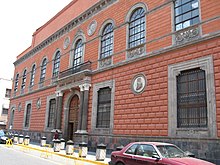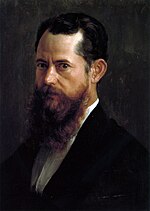Academy of San Carlos
 Academy of San Carlos on Academia Street | |
| Parent institution | Faculty of Arts and Design (UNAM) |
|---|---|
| Founder(s) | Charles III of Spain |
| Established | 1781 |
| Focus | Arts (graduate courses, mainly classical European traditional arts) |
| Formerly called | Academy of the Three Noble Arts of San Carlos: architecture, painting and sculpture of New Spain |
| Location | , |
| Coordinates | 19°25′59″N 99°07′44″W / 19.433086°N 99.128844°W |
| Website | https://academiasancarlos.unam.mx |
The Academy of San Carlos (
The Academy of San Carlos was integrated with the National Autonomous University of Mexico, eventually becoming the Faculty of Arts and Design, which is based in Xochimilco. Currently, only graduate courses of the modern school are given in the original academy building.[1][2]
History


The Academy of San Carlos was founded in 1783, being the first arts academy established in America in 1783, with European teachers, and bright students. In 1540 the building was built in order to create the first hospital for people with syphilis. Its name was "Hospital del Amor de Dios", and was closed in 1783 in order to fuse itself with the hospital of San Andrés in the old college of Jesuits on Tacuba street.[3]
Jerónimo Antonio Gil, a famous engraver, established in 1778 an engraving school by the order of the Spanish King. Gil and his partner Fernando José Mangino decided to create a new academy to teach painting, sculpture and architecture. Finally, in 1781 classes started on the Real Casa de Moneda thanks to the donations of rich people, churches, the Tribunal of Trade and the states of Veracruz, Querétaro, Guanajuato, Córdoba Veracruz, and Orizaba.
Jeronimo Antonio Gil was appointed the school's first director by
The Royal Card of establishment was issued on December 25 of 1783. It was asked by the viceroy Martín de Mayorga to the King Carlos III. They choose San Carlos as patron saint.


On November 4 of 1785, courses were officially started in the Academy of the Noble Arts of San Carlos of the New Spain. In 1788, the Academy of San Fernando in Spain sent some teachers like the famous Manuel Tolsá who was in charge of architecture and sculpture.
Aspirations of growing were massive. So the Academy of San carlos tried to finance a building that Tolsá was designing on Nilpantongo Street, but it was way too expensive and it was paid by the Royal Seminar of Mining. Without a building of their own, the academy asked for the forsaken one of the Hospital Amor de Dios and finally in 1787 they started classes there.
Since its founding, it attracted the country's best artists, and was a force behind the abandonment of the Baroque style in Mexico, which had already gone out-of-fashion in Europe.[1]
In the early 19th century, the academy was closed for a short time due to the
The academy continued to advocate classic, European-style training of its artists until 1913. In that year, a student and teacher strike advocating a more modern approach ousted director
Alumni and associated artists

Some of its most famous first teachers included Miguel Constanzó in architecture, José Joaquín Fabregat in metal engraving, Rafael Ximeno y Planes in painting and Manuel Tolsá in sculpture. Another notable teacher here was Pelegrí Clavé, who was noted for his expertise in creating portraits of heroes and biblical figures.[2]
José María Velasco is considered the greatest artist associated with the academy, famous for his landscapes of the Valley of Mexico and a mentor of Diego Rivera. Other artists linked to the academy are Manuel Rodríguez Lozano, Alfredo Zalce, Andrés José López, José Chávez Morado, Francisco Moreno Capdevila, Luis Sahagún Cortés, Gabriel Fernández Ledesma, Roberto de la Selva and Jorge Figueroa Acosta.[2] Matusha Corkidi studied at the academy.[4]
Mexican muralists Elena Huerta Muzquiz and Electa Arenal both attended the Academy of San Carlos.[5][6][7]
Architects

A number of important nineteenth-century architects studied at the academy, including Juan (b. 1825) and Ramón Agea (b. 1828), who were sent to Rome by the academy to study with Cippolla. They sent back sketches of Roman monuments that served as models for Academy students. They went on to be professors at the academy as well as working architects in Mexico City. They completed the Monument to Cuauhtémoc on Paseo de la Reforma after the death of the engineer in charge.[8] Another notable graduate (1863) is architect Manuel Francisco Álvarez, who was also a civil engineer. Álvarez was a city counsellor (regidor) of the capital, president of the Asociación de Ingenieros y Arquitectos, a founding member of the Asociación Francesa para el Desarrollo de la Enseñanza Técnica, Industrial y Comercial; director of the Escuela Nacional de Artes y Oficios; and a member of the Academy of France, and author of many books on architecture.[9]
Building


The building originally was as the Amor de Dios Hospital, which had closed by the time the School of Engraving decided to move there from the mint building. Founding director
A number of plaster casts of classic statues from the
Gallery
The academy once had a very large collection of art in the Gallery of the San Carlos Academy, considered the first museum of art in the Americas.
See also
References
- ^ a b c d "Academia de San Carlos" (in Spanish). Archived from the original on 2009-04-09. Retrieved 2009-03-30.
- ^ ISBN 9685437297.
- ISBN 9786070210990.
- ISBN 9781135638825.
- ^ Francisco Tobías (May 20, 2013). "Elena Huerta". Saltillo: Zocalo. Retrieved 23 June 2015.
- ^ Guillermina U. Guadarrama Peña. "Pese a todo Elena Huerta fue muralista Crónicas". Crónicas. UNAM. Retrieved 23 June 2015.
- ISBN 9781135638894.
- ^ Israel Katzman, Arquitectura del siglo XIX en México. tomo 1. Mexico: Centro de Investigaciones arquitectónicas. Universidad Nacional Autónoma de México 1973, p.266.
- ^ Katzman,Arquitectura del siglo XIX en México p. 267
- ^ a b "Nacional Museum of San Carlos". Archived from the original on 2008-12-03. Retrieved 2009-03-29.
- ^ "Academia San Carlos, Mexico City". Archived from the original on 3 May 2009. Retrieved 2009-03-30.


